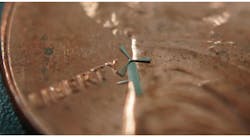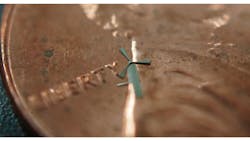Giant windmills now command the landscape and even some seascapes in the quest for renewable energy resources. Researchers at the University of Texas Arlington, however, are taking the technology behind these titan turbines and shrinking it to power portable electronics. Measuring 1.8 mm at their widest point, hundreds of these micro-windmills could be embedded in a sleeve for a cell phone (see the figure).
Related Articles
- The Wind Turbine Of The Future
- Wind Turbines Play In Paradise, But Not In Falmouth
- Innovative Designs Keep Power Turbines Spinning
Developed by Smitha Rao and J.C. Chiao, the windmills blend origami concepts into conventional wafer-scale semiconductor device layouts so complex 3D movable mechanical structures can be self-assembled from 2D metal pieces utilizing planar multilayer electroplating techniques that have been optimized by WinMEMS Technologies Co.
“The micro-windmills work well because the metal alloy is flexible and Smitha’s design follows minimalism for functionality,” Chiao said.
WinMEMS became interested in the microelectromechanical-systems (MEMS) research and started a relationship with UT Arlington. The university will hold the intellectual properties, while the company will explore the commercialization opportunities. UT Arlington has applied for a provisional patent.
The micro-windmills operate under strong artificial winds without any fracture in the material because of the durable nickel alloy and smart aerodynamic design. Typical MEMS materials would be too brittle. They can be made in an array using batch processes. The fabrication cost of making one device is the same as making hundreds or thousands on a single wafer, enabling mass production of inexpensive systems.
“Imagine that they can be cheaply made on the surfaces of portable electronics,” Chiao said, “so you can place them on a sleeve for your smart phone. When the phone is out of battery power, all you need to do is put on the sleeve, wave the phone in the air for a few minutes, and you can use the phone again.”
Chiao further noted that thousands of windmills could be made and mounted on the walls of houses or buildings to harvest energy for lighting, security, or environmental sensing and wireless communications.

